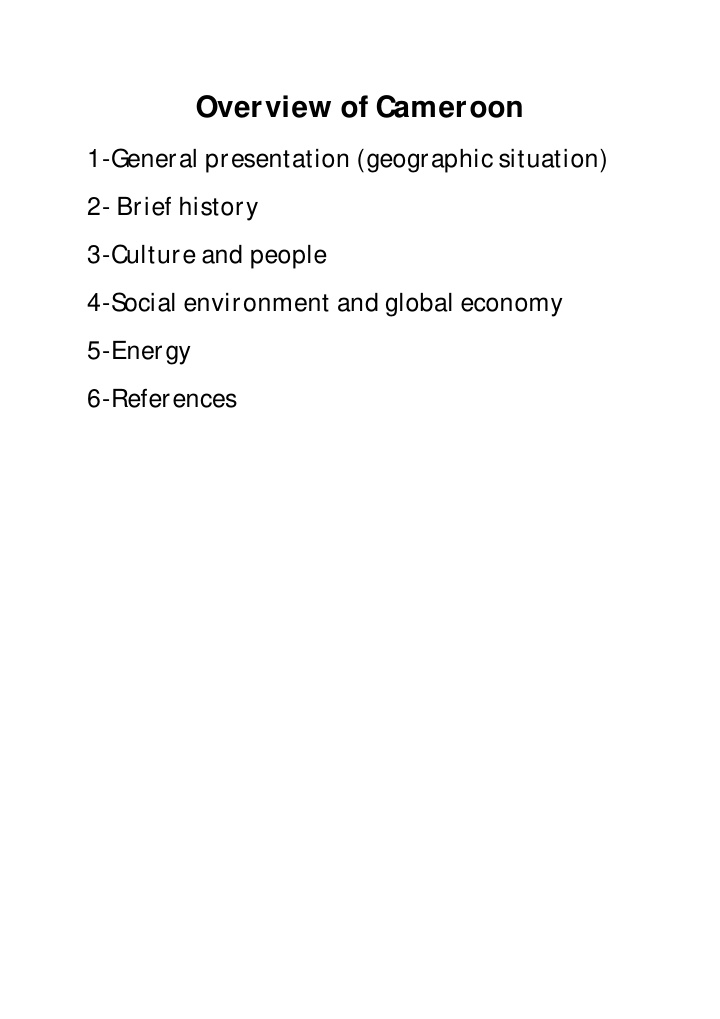



Overview of Cameroon 1-General presentation (geographic situation) 2- Brief history 3-Culture and people 4-Social environment and global economy 5-Energy 6-References
1. General Presentation Fig1: Cameroon situated in the central Africa . Fig2: Cameroon and neighborhood countries. (Source Google map) Motto: Peace-Work-Fatherland Area: 475,000 km 2 or 183,398.52 mi sq (California: 414,000 km 2 ) Population: 20,000,000 national census 2010. Currency: CFA Franc (XAF) 1$=450 XAF Official languages: English and French Other languages: 250+ Independence: 1960
2. Brief history Portuguese first arrived in 1472 named the country “ Rio dos Camarões ”, due to the abundance of lobster in the Wouri river, followed by the European missionaries later 1884: Kamerun became a colony of the German empire. In 1919 After the World war 1, the country is divided between British and French In 1960 the French part became independent The question for the British part was whether to reunify to French Cameroon or join Nigeria. 1 October 1961 after a long and decisive pool, the British make his choice for the reunification of the 2 Cameroon
3. People and culture. Fig3: Peulh or Fulbe and Hausa from the North Cameroon Fig4: typical Bantu from Cameroon. Culture in the North part is similar, but in the south part in mostly depends on the ethnics groups or tribe because we have 250 ethnics groups. The best of the culture from my side is the traditional dancing, painting, sculpture.
Fig4: Traditional dance and mask from the west Cameroon
4. Social environment and global economy 4.1. Politics. Country Cameroon US 1 Ahmadou Ahidjo (1960) J ohn F. Kennedy (1961- 1963) 2 Ahmadou Ahidjo Lyndon B. J ohnson (1963-1969) 3 Ahmadou Ahidjo Richard Nixon (1969- 1974) 4 Ahmadou Ahidjo Gerald Ford (1974- 1977) 5 Ahmadou Ahidjo (1982) J immy Carter (1977- 1981) 6 Paul Biya (1982) Ronald Reagan (1981- 1989) 7 Paul Biya George Bush (1989- 1993) 8 Paul Biya Bill Clinton (1993- 2001) 9 Paul Biya George W. Bush (2001- 2009) 10 Paul Biya Barack Obama (2009- 2012) 11 Paul Biya to ????????????? (2012- date 2016) Presidential political system, with parliament and senate ( from the French political system). All the powers are centered at the same place in Yaounde.
4.2. Population. (20,000,000) Religions: indigenous beliefs 40%, Christian 40%, Muslim 20% Gender representation: 51.6% women and 48.4% men, Median age: 19.6 years. Population growth rate: 2.082% (2012), Median age: 19.6 years Population growth rate: 2.02% (2012) Urbanization: Urban population: 58% of total population Rate of urbanization: 3.3 % annual rate of change (2010- 15 est) Life expectancy at birth: Total population: 54.71 years Male: 53.82 years Female 55.63 years. Children under the age of 5 years underweight:
16.6% (2006) Literacy: Define as people over 15 years who can read and write: Total population: 75.9% Male: 84 % Female: 67.8% 4.3. Economy The general incomes are based on oil resources, agriculture, mineral resources and minor exportations. Gross domestic product (GDP): $47.86 billion Gross domestic product (GDP) per capita: $2,300 Growth rate: 3% GDP- composition by sector: Agriculture: 19.5 % Industry: 31% Services : 49.5% Labor force - by occupation:
agriculture: 70% industry: 13% services: 17% (2001 est.) Unemployment rate: 30% (2001 est.) Population below poverty line: 48% (2000 est.) Inflation rate (consumer prices): 2.9 % (2011 est.) Agriculture - products: coffee, cocoa, cotton, rubber, bananas, oilseed, grains, cassava (manioc); livestock; timber Industries: petroleum production and refining, aluminum production, food processing, light consumer goods, textiles, lumber, ship repair 5. Energy Electricity - production: 5.421 billion kWh (2008 est.) Mainly for hydroelectric and gas central Electricity – Needed : 11.000 billion KWh
Electricity - exports: 0 kWh (2009 est.) Electricity - imports: 0 kWh (2009 est.) Due to the deficit in energy, all the new sources of energy are welcome. Unfortunately, the new investments in the power sector are mostly for companies and factory, therefore people from the rural area can not benefit from the new installment. I can say nearly 50 % of people are connected to the national grid. In the major cities like Yaoundé or Douala, everything is Ok, but in the second zones, they are regularly a shortage of power which can sometime last for weeks. Investment in the new source such as solar panel, winding energy etc. are welcome, but they should be cost efficient otherwise they will benefit only for the wealthy people, who are connected to the national grid.
6. References 1- https:/ / www.cia.gov/library/ publications/ the-world-factbook/ geos/ cm.html 2- https:/ / maps.google.co.za/ 3- http:/ / en.wikipedia.org/ wiki/ Cameroon
Recommend
More recommend